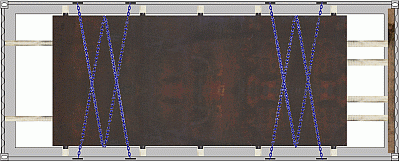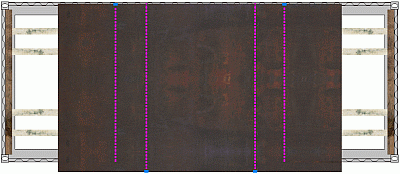 |
|
| Heavy plate secured with loop lashings and wooden bracing |
The nature of the flatrack's end walls determines whether it is possible to secure metal plates in the lengthwise direction only with wooden members loaded against the end grain (left) or whether wooden members loaded against the face grain have to be inserted to distribute the pressure (right). The different loading capacities of the wooden members can mean that different numbers of members have to be used.
 |
|
| Overwidth plate - loaded with overhang on one side and secured with claws |
Slightly overwidth plates are loaded such that they overhang on only one side so that only two slot rates rather than three need be paid. Securing can be provided by claws fasted to belts, wire ropes, chains or the ends of the lashings on permanently installed reels. Since the lashing means have to be passed and fastened from under the cargo, it is advantageous to lay them out prior to loading, to apply the claws after loading and then to apply tension. Claws may also be replaced with suitably strong hooks with an adequate throat size.
 |
|
| Plate overhanging on one side - secured with claws - cross-section |
It is important for the lashings always to be applied from the opposite side. Otherwise, the angles are so unfavorable that sufficient lateral forces cannot be applied.
 |
|
| Unusable: tie-down lashings |
Tie-down lashings must never be used to provide lateral securing as plates remain freely mobile under such lashings. However, such lashings can be used to provide vertical securing. In this case, they should then be viewed as direct lashings preventing upwards movement and so require only slight pretensioning. Such securing methods can ideally complement lateral securing with claws.
 |
|
| Overwidth plate - loaded with overhang on one side and secured with stanchions and loop lashings applied on one side |
Using flatracks with stanchions simplifies securing. In this case, the plates are laid with one side against the stanchions, while movement towards the other side is prevented with loop lashings or lashings fitted with claws.
 |
|
| Overwidth plate - loaded with overhang on one side and secured with stanchions and direct lashings with claws applied on one side - cross section |
 |
|
| Overwidth plate - loaded with overhang on one side. Secured with stanchions and specially shaped stanchions applied on one side - cross-section |
 |
|
| Overwidth plate - loaded with overhang on both sides - secured with specially shaped stanchions - cross section |
Depending upon the plate sizes to be transported, it may be advisable to use specially shaped stanchions. If these are not an exact fit, relatively small gaps can be filled in with lumber. The securing action of stanchions or specially shaped stanchions should be complemented by direct overlashings. As already mentioned, such lashings are applied in the same way as tie-down lashings, but they are not tie-down lashings as they do not act in the same way.